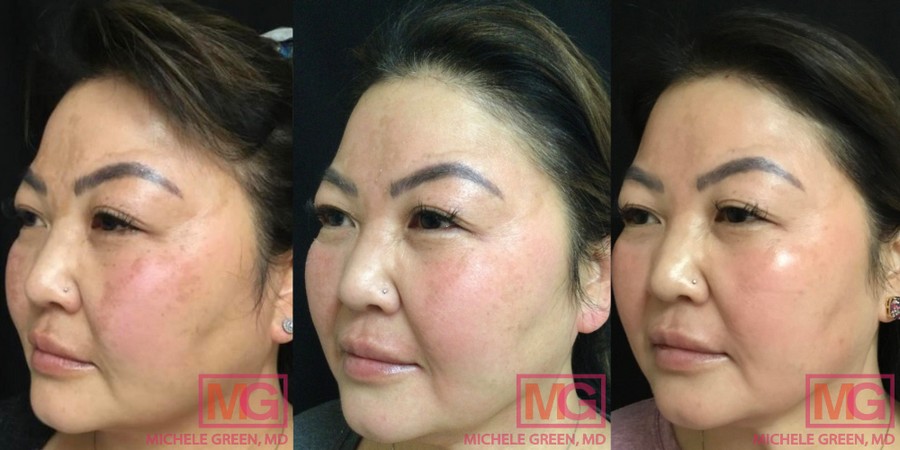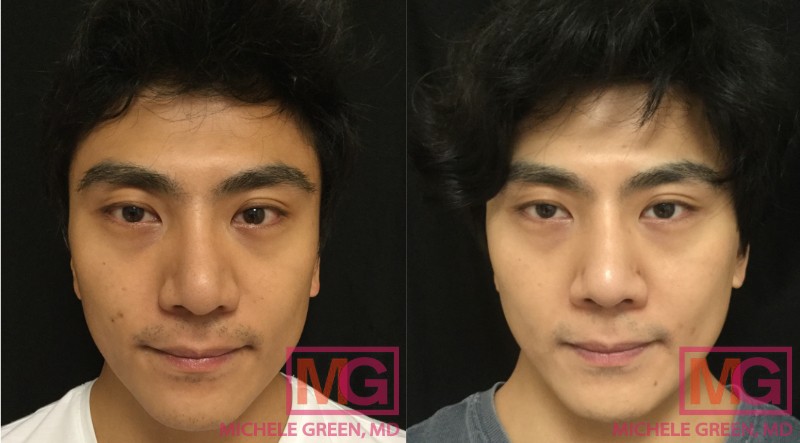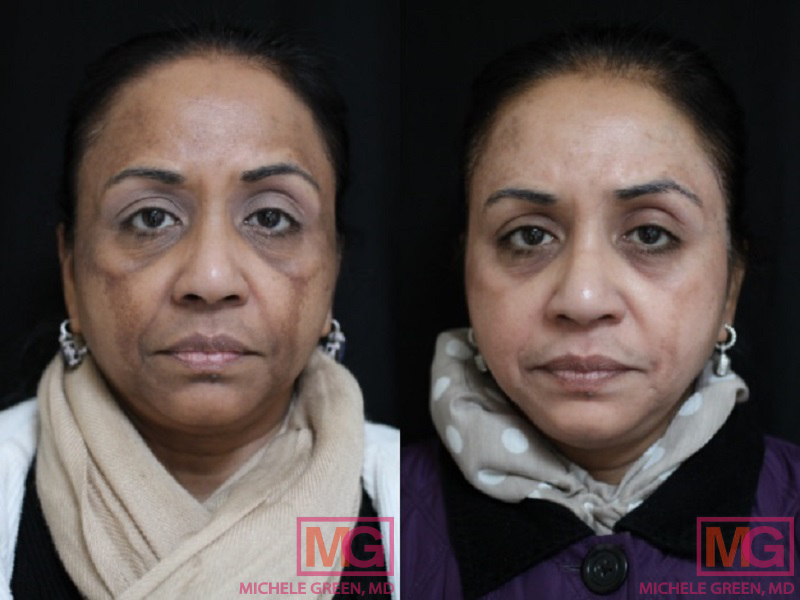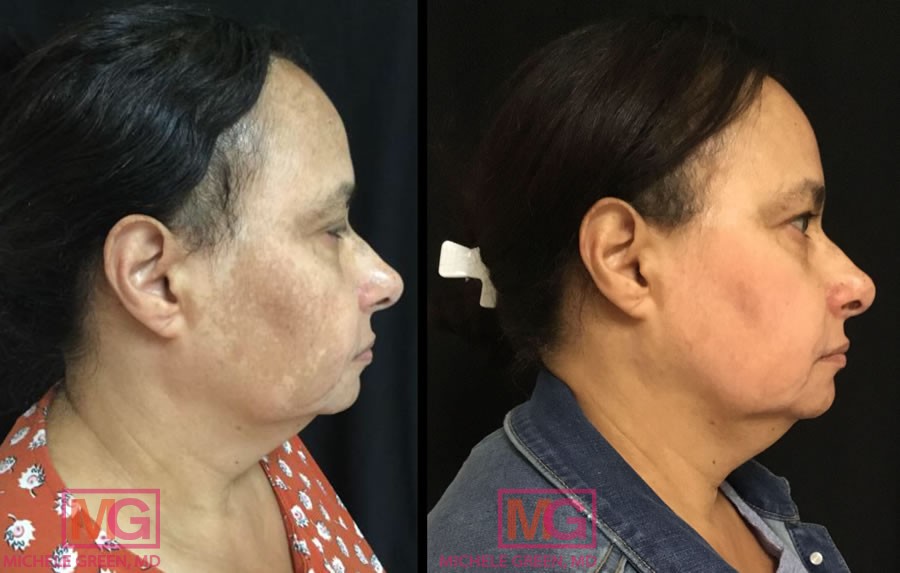How Does a Chemical Peel Work?
According to the American Society of Plastic Surgeons, chemical peels are in the top five most popular non-invasive cosmetic treatments in the United States, as they are highly versatile and can treat a wide range of skin conditions. Many different types of chemical peels can be used nearly everywhere on the body, including the face, neck, decolletage, back, underarms, and vaginal area. Depending on the depth or type of acid peel, chemical peels can be used to exfoliate the top layer of skin to erase fine lines and wrinkles, improve hyperpigmentation, melasma, or discoloration on the skin, ameliorate uneven skin tone and texture, reduce the appearance of sun damage, age spots, and acne scars, and cure active acne breakouts. With a wide range of chemical peel treatment options, it is best to consult an expert, board-certified dermatologist, such as Dr. Michele Green, to determine which type of chemical peel is right for you and to answer questions such as “How does a chemical peel work?”
Chemical peels work by applying a chemical solution onto the top layer of skin, known as the epidermis, which reacts with the dead skin cells, causing the skin to peel and new skin to form. The exfoliation of dead skin cells on the outer layer of the skin leads to increased production of the structural protein collagen, which, in turn, improves skin tone and texture. The exfoliation of the skin can be superficial or more dramatic depending on the depth of the chemical peel, as medium-depth peels and deep chemical peels can penetrate the dermis or inner layer of the skin. Chemical peels are an extremely popular cosmetic procedure not only due to the many anti-aging benefits of the treatment but also because superficial peels and medium-depth peels require no significant downtime.
To begin your treatment process to reduce signs of aging and improve the skin tone and texture, it is best to schedule an appointment with experienced dermatologist Dr. Green. Dr. Green has been expertly treating patients at her Upper East Side New York City dermatology office for more than 25 years. A master in a wide range of cosmetic procedures, Dr. Green is well-known for her individualized treatment plans that consider each patient’s unique needs. When it comes to choosing the right chemical peel, Dr. Green will weigh each patient’s desired results, skin type, and level of sensitive skin for the safest, most effective treatment plan. In addition to chemical peel treatment, Dr. Green is an expert in many cosmetic procedures, including dermal fillers, Botox, laser resurfacing, microneedling, and more. Acclaimed for high patient satisfaction, Dr. Green has been voted one of New York City’s best healthcare providers in such publications as New York Magazine, Castle Connolly, and Super Doctors.
What is the purpose of a chemical peel?
Chemical peels have many uses for improving skin tone and texture and reducing the signs of the natural aging process via the exfoliation of the outer layer of skin. As we age, fine lines and wrinkles become etched on the skin’s surface, too much sun exposure can lead to sun spots, age spots, and freckles, and acne breakouts can leave scars that remain long after the initial breakout has healed. Other forms of hyperpigmentation, such as rosacea and melasma, can also develop on the face, making patients feel self-conscious. Chemical peels can be employed to improve all of these signs of the natural aging process, resurfacing the skin and providing patients with clear, bright, smooth, evenly-textured skin without the need for plastic surgery or other invasive treatment.
How does a chemical peel work?
Chemical peels provide patients with even skin texture and tone by exfoliating the epidermal layer of skin, creating controlled micro-injuries that boost collagen production and promote skin cell turnover. Chemical peels are composted of various forms of acidic chemical solutions, which react with the dead skin cells on the skin’s surface to break down chemical bonds, causing the skin to peel away. This flaking triggers the body’s natural healing response, producing new collagen and skin cells that are smoother and brighter. The deeper the chemical peel, the deeper the chemical solution will penetrate, reaching layers of the dermis to improve the appearance of deeper wrinkles and atrophic acne scars and even treat early forms of cancerous lesions. A deeper chemical peel is more powerful, meaning there is a greater risk of side effects. It should not be used on patients with darker skin, as there is a risk of developing post-inflammatory hyperpigmentation.
What does a chemical peel help with?
Chemical peels are a very versatile treatment that can be used on many areas of the body to treat a wide range of skin conditions. When applied to the outer layer of skin, chemical peels work to:
- Improve skin color and texture
- Correct hyperpigmentation and discoloration
- Erase signs of too much sun exposure, such as age spots, sun spots, freckles
- Treat active acne breakouts
- Reduce the appearance of acne scars, particularly atrophic – or depressed – acne scars
- Improve the appearance of melasma
- Treat rosacea
- Unclog the pores and reduce pore size
- Treat actinic keratoses and other pre-cancerous lesions (deep chemical peels)
With so many different types of chemical peels and skin conditions that can be treated, it is best to consult with a board-certified dermatologist, such as Dr. Green, to determine which depth and type of chemical peel that is best for you.

What happens during a chemical peel?
The treatment process will begin with a consultation with Dr. Green, who will examine the treatment area and ask about your medical history and desired results to determine the type of chemical peel that best meets your needs. Patients with active cold sores, eczema, or psoriatic flares should not receive a chemical peel treatment. Before treatment begins, Dr. Green may prescribe patients a retinoid or hydroquinone cream to apply during the week leading up to treatment to improve the results. Some patients taking certain types of acne medication, such as benzoyl peroxide, may be asked to pause their medication in the weeks leading up to the chemical peel treatment, as benzoyl peroxide can dry out the skin and contribute to a worsening of side effects, such as skin irritation.
Once Dr. Green has determined the type of chemical peel that will be best for you, she may begin the treatment by applying the chemical solution to the treatment area. Dr. Green will let you know the length of time that the solution must remain on the skin’s surface before being gently wiped away. Patients may feel a mild tingling or heat on the skin’s surface while applying the acid peel, but this is normal, and any discomfort during the procedure is temporary. After the peel has been removed, Dr. Green may apply a cool compress or neutralizing solution to help cleanse the skin and alleviate any discomfort. In the weeks during or following the chemical peel treatment, patients must practice strict sun avoidance and wear sunscreen of at least SPF 30 anytime they go outside during the day.
How long does a chemical peel take to work?
When patients ask how long does it take for a chemical peel to work, the answer is that it depends on the type of peel being used. Typically, flaking and peeling will begin within 48 hours of receiving the chemical peel; the full recovery time depends on the peel’s depth. Light chemical peels are superficial, only affecting the epidermis or outer layer of skin, meaning that the recovery time is relatively brief, lasting only a few days. Medium-depth peels will often take 1-2 weeks to heal fully. In contrast, deep chemical peels can take several weeks to a month, depending on the chemical solution used, the patient’s skin type, and the skin condition being treated.
When does a chemical peel start peeling?
Patients often ask how long a chemical peel takes to start peeling. Following the chemical peel treatment, peeling or flaking typically begins within 48 hours. Peeling is a normal part of the chemical peel process as the acid solution reacts with the dead skin cells causing them to slough off and be replaced with clearer, smoother skin. During the peeling process, patients should be advised not to pick, pull, or peel the flaking skin, as this can irritate and disrupt the healing process. Following the procedure, Dr. Green will provide patients with all of the aftercare instructions necessary to ensure that the skin heals properly and any side effects, such as irritation to the skin, can be avoided.
What is the aftercare for chemical peels?
In the days following the chemical peel procedure, patients will experience peeling, flaking, and general skin tightness as the resurfacing and skin cell turnover occur. For the skin to heal properly and stay irritation-free during the recovery process, there are several important aftercare instructions to note: Dr. Green advises all of her patients to use gentle skincare products, including gentle cleansers and moisturizers, to keep the skin hydrated and relieve discomfort following the treatment. It is extremely important to practice strict sun avoidance, as sun exposure during the chemical peel treatment or healing process can irritate the skin and cause hyperpigmentation and discomfort. It is best to stay indoors during the peak sunlight hours between 10 am and 2 pm or to wear sunscreen of at least SPF 30 whenever you are outside. Dr. Green recommends sunscreen that protects against both UVA and UVB rays. For patients who have stopped their acne treatment before the chemical peel procedure, avoiding exfoliants such as benzoyl peroxide, glycolic acid, or salicylic acid for another two weeks post-treatment is important. Further, patients should avoid extreme heat or intense exercise in the days following a chemical peel, as these activities can cause further discomfort and irritation to the skin.

Does a chemical peel hurt?
Most patients feel minimal discomfort when receiving a light chemical peel or a medium-depth chemical peel, the two most common types of chemical peel. When the peel is applied to the skin, patients may experience a mild stinging sensation or heat when the acid peel is first applied. This feeling typically goes away when the peel is removed, and often, Dr. Green will apply a cool compress or neutralizing solution to the skin to further increase patient comfort. Deep chemical peels, reserved for treating deep wrinkles or pre-cancerous lesions, are often more painful, as the phenol acid used is much more powerful and penetrates the deeper layers of skin. For deep peels, Dr. Green will administer general anesthesia to ensure patient comfort during the procedure.
What is the best skincare procedure after receiving a chemical peel?
In addition to the cosmetic procedures available at Dr. Green’s NYC dermatology office, Dr. Green offers a wide range of skin care products through her proprietary MGSKINLABs. Skincare is essential following a chemical peel treatment as the exfoliating acid peel can irritate the skin and increase sensitivity to sunlight. First and foremost, Dr. Green advises that patients practice strict sun avoidance and always wear sunscreen of at least SPF 30 when going outside. Suppose patients expose the treatment area to the sun during or after the chemical peel treatment process. In that case, the skin can become irritated, and the underlying skin condition that the chemical peel aims to solve could worsen. Not irritating the skin with other exfoliants after the procedure is important. Dr. Green recommends keeping the skin clean and hydrated with a gentle cleanser, light moisturizers, and serums. Directly after the chemical peel treatment, Dr. Green will fully explain the aftercare process and recommend the best skin care products to keep your skin smooth and hydrated.
Are the results of a chemical peel permanent?
Chemical peels work to resurface and exfoliate the skin to slough off dead skin cells and promote increased cell turnover for new, smooth, bright skin. Through this process, chemical peels can reduce the appearance of acne scars, sun damage, hyperpigmentation, and fine lines on the skin’s surface. While chemical peels can treat these skin conditions, it is possible that new evidence of sun damage, acne scars, or fine lines can develop and occur on the skin over time. For this reason, it may be best to receive chemical peels every year to maintain results.
What are the different types of chemical peels?
Three overarching types of chemical peels are available: light chemical peel, medium-depth chemical peel, and deep chemical peel.
Light Chemical Peel – The light chemical peel, also known as the superficial chemical peel, is the least intense form of chemical peel available and is usually safe and effective for patients of all skin types. Patients dealing with a skin condition that affects only the outermost layer of the skin can turn to superficial chemical peels to resolve the issue. Types of light chemical peels include:
- Alpha Hydroxy Acid Peels: These are the most gentle form of chemical peels, including glycolic acid peels. Alpha hydroxy acid peels are effective for treating fine lines, minor acne breakouts, and mild discoloration on the skin’s surface.
- Beta Hydroxy Acid Peels: These chemical peels, which include salicylic acid peels, help to control oil production on the skin’s surface, helping to reduce acne breakouts.
- Jessner Peel: Composed of lactic acid and resorcinol, Jessner peels are effective in brightening and hydrating the outer layer of skin.
Medium-Depth Chemical Peel – Medium chemical peels penetrate past the epidermal layer of skin into the dermis to improve skin texture and tone. Some medium-depth peels may not be safe for patients with darker skin tones, so it is always best to start with a lower concentration of chemical solution for patients with darker skin. The trichloroacetic acid peel is the most common type of medium-depth or TCA peel. The TCA peel is highly effective in treating sun damage, deep wrinkles, depressed acne scars, and melasma.
Deep Chemical Peel – The deep chemical peel is the strongest form of chemical peel that penetrates the deeper layers of the dermis and requires much more recovery time. The most common type of deep chemical peel is the phenol peel, which can be used to treat deep wrinkles, severe atrophic acne scars, deep sun damage, and pre-cancerous cells. Deep chemical peels are unsafe for patients with darker skin tones, as deep peels can cause lasting side effects such as post-inflammatory hyperpigmentation.

What is a TCA peel used for?
A TCA peel is a medium-depth peel of trichloroacetic acid that can be used at different concentrations to treat various skin conditions. A TCA peel can often treat deep lines, wrinkles, and skin discoloration from hyperpigmentation or too much sun exposure. One type of trichloroacetic acid peel that is particularly effective at treating atrophic acne scars, such as ice-pick scars, is the TCA Cross. Atrophic acne scars form depressions on the skin’s surface, resulting in uneven skin texture. 70-100% strength trichloroacetic acid is placed directly into the scar, forming a “frost” and creating micro-injuries to boost collagen and elastin production, improving skin texture and filling in the indents on the skin. For the TCA cross to be most effective, Dr. Green recommends several treatment sessions spaced six to eight weeks apart.
Will a chemical peel help acne?
Acne is caused when an excess of oil and dead skin cells on the skin’s surface clog the pores, resulting in inflammation and pimples. Sometimes, bacteria also gets trapped in the pores resulting in inflammatory acne and painful pustules or nodules. A chemical peel can help clear an active acne breakout and prevent future breakouts. Typically for acne, Dr. Green will use a light chemical peel, such as a glycolic acid peel, which will help to exfoliate the skin to clear the pores. Another option Dr. Green might turn to is the salicylic acid peel, which reduces sebum production to prevent the pores from clogging with excess oil.
Does a chemical peel work for acne scars?
The most effective acne peel for acne scars is the TCA Cross, which works particularly well for difficult-to-treat atrophic acne scars, such as ice-pick scars. When an acne lesion becomes infected with bacteria, the inflammation can break down the tissue and interfere with the healing process following the active outbreak, which can lead to insufficient collagen produced during the wound healing process. As a result, depressed acne scars form, characterized by indentations or craters on the skin’s surface. To improve the skin texture, Dr. Green will often turn to the TCA peel known as the TCA Cross, which resurfaces the skin to improve the texture, reducing the appearance of atrophic acne scars.
What does a chemical peel do for the face?
There are many uses for chemical peels on the face, and depending on the type and depth of the peel, many different skin conditions can be addressed. The natural aging process can wreak havoc on the skin, from the development of fine lines and wrinkles on the face to overexposure to the sun, which can leave sun spots and hyperpigmentation. Additionally, acne breakouts can leave behind acne scars that can permanently mark the face. Chemical peels can reduce the appearance of fine lines and wrinkles, hyperpigmentation and discoloration, acne scars, melasma, and rosacea and improve skin texture for brighter, smoother, more youthful-looking skin.
How effective are chemical peels?
Chemical peels are highly effective at reversing signs of the natural aging process and improving skin texture by resurfacing the epidermal layer of skin and promoting increased skin cell turnover. Chemical peels are one of the most popular non-invasive procedures in the United States – ranking in the top five most performed non-invasive cosmetic treatments – as they can address so many different skin concerns. By exfoliating the outer layer of skin, new skin is formed in the treatment area, which reduces the appearance of sun damage, hyperpigmentation, fine lines, wrinkles, acne scars, and acne breakouts.

Where do you get a chemical peel?
With so many different options for types and depths of chemical peels, it is best to consult an expert, board-certified dermatologist, such as Dr. Michele Green. Dr. Green performs a wide range of chemical peels at her Upper East Side office in New York City and can consider each patient’s desired results when creating their ideal treatment plan. With many cosmetic treatments at her office, Dr. Green can pair chemical peels with other treatment options for full facial rejuvenation.
Can you perform a chemical peel at home?
When performing a chemical peel at home, it is best to receive instructions and guidance from your dermatologist. A light chemical peel for acne breakouts, sun damage, or fine lines can be safely performed at home. However, it is very important not to over-peel the skin, as that can cause irritation and damage to the skin. Deeper chemical peels should never be performed at home – they should only be performed by an expert dermatologist, as there are potentially dangerous side effects associated with the treatment when performed incorrectly. For at-home acne control, Dr. Green recommends MGSKINLABs’ retexturing pads, which can be used to reduce excess oil production and prevent future acne breakouts.
How to get started with dermatologist Dr. Green today
With so many options available, from light chemical peels to deep chemical peels, it can be difficult to know what type of chemical peel is best and how it can work best to treat your skin condition. Luckily, the wide varieties of chemical peels are available at Dr. Green’s NYC dermatology office. Whether you are looking to combat signs of the natural aging process, such as fine lines, wrinkles, sun spots, age spots, or acne scars, or looking to reduce the appearance of hyperpigmentation, melasma, and rosacea, Dr. Green has a chemical peel that will work for you, regardless of skin type and sensitivity.
Dr. Michele Green is an internationally renowned board-certified cosmetic dermatologist with over two and a half decades of experience providing some of the world’s most discerning individuals with the best non-invasive treatment options, including chemical peels. For her dedication to her patients and expertise, she is consistently identified as one of New York City’s best dermatologists by Castle Connolly, New York Magazine, the New York Times, and Super Doctors. When you consult with Dr. Green regarding rejuvenation, she will work with you to create a personalized treatment plan that incorporates a combination of in-office procedures and specially formulated skincare products best suited to address your specific concerns and achieve your ideal aesthetic goals. To schedule a consultation, please get in touch with the office of Dr. Green online or call our New York City office at 212-535-3088 to learn more about how chemical peels can work for you.
 212-535-3088
212-535-3088